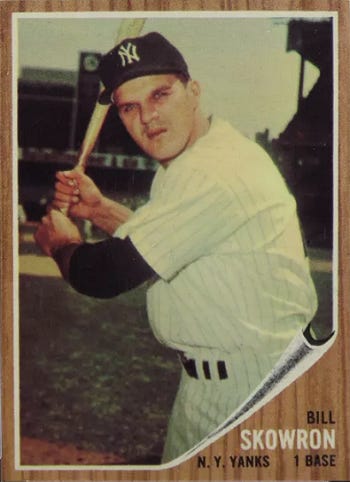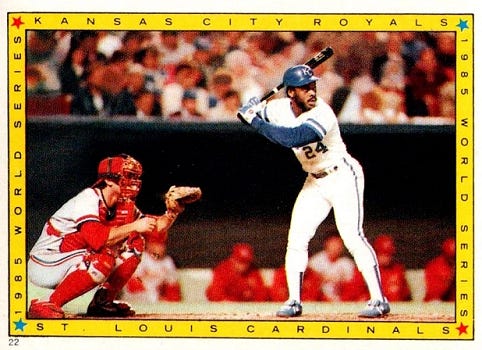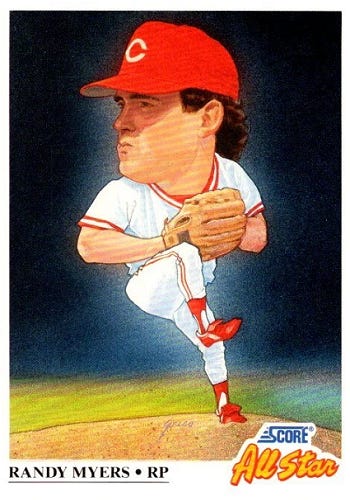Today is a big day for kids of the eighties, because today we celebrate Kevin Gross’s birthday. Which is a perfect opportunity to practice mashing up two of our childhood icons.
I’m talking about baseball cards and Garbage Pail Kids, of course. I’ll leave you to imagine what a Kevin Gross GPK card might look like. Shouldn’t be much of a stretch.
And if you do get stumped, let me just mention that Grok came up with a couple of, uh, gross examples, lickety-split, when I asked. The really good news, though, is we don’t need any AI- or otherwise-concocted cards to effect our Kevin celebration.
No, we have real baseball cards that can do the trick. Probably hundreds or thousands of them, at least if you’re willing to look at them just right. Or just wrong.
Here are five to get you started.
Green-Around-the-Gills Ill Bill
Jay Leno Moose Skowron already looks a bit uneasy on this card.
Maybe it’s because he hit under .270 for the first time ever in 1961, and struck out more than 100 times. He was also 30 years old in ‘61, when this pic was (maybe) snapped — maybe he’d heard that slugging first basemen fall apart in their thirties.
Heck, maybe he was starting to believe the Joe Pepitone hype, which would indeed lead the Yankees to trade Skowron to the Dodgers for Stan Williams in November of 1962.
Or maybe Moose just never looked all that happy or sanguine. Most of his cards are a bit scowly if I remember right.
Whatever the case, Topps ramped up the queasiness on this particular card by tinting it green. In fact, they tinted the entire second series green, starting with Barney Schultz at card #89 and stretching all the way through Eddie Yost at card #176.
Surprisingly, the maths say that Bill Skowron, at #110, is included in that range. And so he is, appearing on his green-around-the-gills version above.
For what it’s worth, some cards are more striking in their greenness than others, with the Babe Ruth specials (#s 135-144) being among the more verdant that I have seen.
Topps did correct the issue, which seems to have been a print-process misstep early in the second-series run. Here is the “red” Moose (not to be confused with Red Bull) for comparison purposes:
He looks more flush to me here, like maybe that dicey taco-truck burrito has finally moved on. Aside from the tinting changes, the second round of second-series cards also featured updated photo cropping — check out the difference in spacing between Skowron’s waist and the right-hand side of the card in the two versions…and the amount of dude who appears near his left hand on the left-hand side of the card.
Bottom line is, there’s plenty of GPK fodder here, including the fact that Topps incorrectly lists Moose’s birth year as 1931 instead of 1930 on the back of the card…even though they had it right in both 1960 and 1963 (but not 1961).
Oh, and for the record, Skowron won his third World Series in a row in 1963, playing first base for the Dodgers in all four games as they swept the Yanks.
Motley Darryl
In classical terms, “motley” describes something that is variegated or patchy in color, or made up of many things or people. In a more recent connotation, “motley” has come to signify threat, danger, destruction…you never know what that motley crew up there on the corner is capable of doing, after all. (To say nothing of the “motley” as a noun, which is a jester/clown/fool/Selig type of creature.)
Darryl Motley always looked like he could live up to his last name, in a dangerous baseball sense, at least. He brought a compact, muscular package to the plate that conjured visions of Rickey Henderson and maybe even premonitions of Bo Jackson.
That 1986 Topps Sticker (#22) up there gives you a glimpse of what pitchers were facing when Motley stepped in. He’s going to work in the 1985 World Series on this “card.”
And Motley did, indeed, prove to be trouble for the Cards in that Fall Classic. His two-run home run in the bottom of the second inning of Game 7 opened the scoring in what eventually became an 11-0 rout for the Royals.
But alas, Motley’s overall big league performance proved to be more motley in the classical sense. Indeed, he splattered splotches of good against a canvas marred with dark stains…
15 homers in 1984 and 17 in 1985, but a lifetime .243 batting average and .280 on-base percentage
10 steals in 1984…but caught stealing 12 times
Serviceable in the outfield corners but not enough to overcome his bat and maintain a starting job
To that last point, Motley began the 1985 season starting in left but struggled to the extent that the Royals traded John Morris (to the Cardinals!) for Lonnie Smith in May and platooned Motley with Pat Sheridan in right. You can see Motley’s final line on the back of his 1986 Fleer card:
From that point, Motley’s career became more motley, too. He split 1986 between the Royals and Braves, spent most of 1987 in Atlanta’s minor league system, and then spent the next 15 summers out of the majors but still in organized ball, bouncing between the minors for three MLB franchises, Mexico, Japan, and several independent teams.
Definitely fodder for a patchwork GPK card.
Foul Ball Brian
On September 1, 1990, Brian Downing led off the bottom of the ninth with his Angels trailing the White Sox, 9-5. Facing reliever Ken Patterson, Downing worked the count to 2-1, then fouled off three straight pitches before taking ball three.
With the count full, Downing then fouled off ten straight pitches. He lined Patterson’s 18th pitch to left field to end the confrontation, which still stands tied for the fifth-longest at-bat (pitch-wise) since 1988. For the record Patterson lasted two more batters and seven pitches before yielding to Bobby Thigpen, who hammered down yet another save (he set a record with 57 that year).
As for Downing, like Motley, he cut a menacing figure at the plate. He was also one of the early vocal proponents of weight training in the game, and his production benefited to the tune of 275 lifetime home runs.
Such was his status in Anaheim that Donruss featured him as the Angels’ Diamond King (#10) in their bloody-mess 1990 set, as you see above. It’s a great choice for our GPK-themed team because it not only has a head start thanks to the animation, it also already engenders that general unease and sense of pending doom that delighted us kids about GPK.
And if you don’t get those vibes from 1990 Donruss, you really ought to see someone about that.
Gross Kevin
Kevin certainly wasn’t the only Gross player in major league history, nor even the only Gross major leaguer of his generation. But he just may have been the most Gross-ly underrated of the entire Gross group.
Consider that Kevin won 10-plus games in a season seven times, including twice when he was primarily a reliever. And his 142-158 record looks a lot better when you consider that the only playoff team he ever pitched for was his first, the 1983 Phillies.
And even then, he didn’t get to play in the postseason (teammate Greg Gross did, though, which supports the theme of underrated Kevin here).
Then, of course, there was that night at Dodger Stadium where Gross was arguably the Gross-est, nastiest pitcher in the game. Gross’s Dodgers hosted the bitter-rival Giants that night, and Gross pitched a two-walk, six-strikeout no-hitter.
So, is it Gross of me to feature today’s birthday boy and underrated pitcher standing in the box, getting set for a sacrifice bunt (1990 Upper Deck #468)? Looking about as confident as a pimple on a first date with the head cheerleader? Defending himself against her father’s inquisition with a popsicle-stick crucifix?
Maybe, but that’s just the way it goes sometimes when you audition for the GPK checklist. And when you’re Gross.
Redundant Nasty Randy
Randy Myers was, by definition, Randy.
And Randy Myers also was, by affiliation and deed, a Nasty Boy.
So, the question is, what sort of dastardly mound character needs to be described as both Randy and Nasty? Well, in this case, it’s a 1990 World Series champion, and since I’m a Reds homer, I should probably just be satisfied with that.
And I am, mostly, though it’s still sorta hard to believe Myers lasted just one more season on the Riverfront before the Reds traded him to the Padres in December of 1991. At least Bip Roberts was a fun return package…and might make a good GP Kid, himself.
As for Myers, his 1991 Score All-Star card (#662 above) is already most of the way to fitting in as a GPK. Maybe a touch of goo here or a lascivious glance there would complete the look, but this is a pretty fun card as it stands.
Which, really, is pretty much the most important thing that any hunk of cardboard can do in its lifetime — be fun.
—
Alright, so what are your favorite could-be-Garbage-Pail-Kids-cards baseball cards? As you can see from my picks above, you have plenty of latitude with this one. Let your imagination run wild and your inner 1980s kid take over for a few minutes.
You might just have fun with it. Maybe as much fun as, say, a properly done-up Speed Bump Wills GPK card. Or maybe as much fun as a puckered Hank Sour GPK.
Happy sillying, and thanks for reading.
—Adam
Last week in the daily newsletter…
Note: When you click on links to various merchants in this newsletter and make a purchase, this can result in this newsletter earning a commission. Affiliate programs and affiliations include, but are not limited to, the Fanatics and Fanatics Events programs (including the links below).
(affiliate link)











